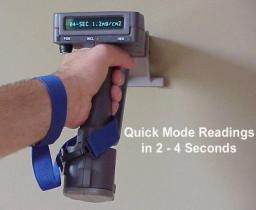|

LPA-1
Analyzer
|
Performance Specifications
| Precision
of Results |
| Wood,
Drywall |
±0.05
mg/cm2 |
| Concrete,
Metal |
±0.10
mg/cm2 |
|
Accuracy of Results
|
| Wood,
Drywall |
±0.05
mg/cm2 |
| Concrete,
Metal |
±0.10
mg/cm2 |
|
Instrument
Characteristics
| Depth
of Penetration |
No
Interference from objects (lead pipes, etc.) beyond 3/8" |
| Substrate
Effect |
Automatic
Substrate Compensation (Spectrum Analysis) |
| Detection
Technique |
X-Ray
Fluorescence (XRF), K-Shell Analysis |
| Weight |
<3
lb. Total (one piece unit includes 1lb battery pack) |
| Ergonomic |
Grip-handle
for ease of measurements & limited operator fatigue. |
| Measurement
Area |
The
face print is smaller than 1.5" X 1.25". |
| System
battery life |
8
hours of normal usage between charges for each battery |
| Battery
Charge Time |
1.5
hours |
| Operating
Temperature |
20-120°F |
| X-Ray
Source |
Cobalt-57
(max 12mCi, 444MBq) |
Radiation
Safety Features
| Manual
Shutter Lock |
The
shutter will not open when the manual shutter lock is
activated. |
| Key
Lock |
A
key activated trigger lock renders the trigger inoperable. |
| Optical
Sensors |
Ensure
that the bezel of the instrument remains flat against
the surface before the shutter can be opened or operated. |
|
|
Radiation
Source
Cobalt-57 (Min. 10
mCi, Max. 12 mCi, 444 MBq)
PROTEC Instrument Corporation's
RMD LPA-1 analyzer radioactive source is a 12 mCi, Cobalt
57 isotope. Co-57 gamma ray energies (122 Kev) are more efficient
(at least 10 times) than those of Cd-109 (22-26 Kev and 88
Kev) source for production of K-shell lead x-rays, which are
recommended by HUD chapter 7 for measurement of lead in paint.
Therefore, the measurement time is shorter using a Co-57 source
Detector
The LPA-1 analyzer utilizes
a "room-temperature" detector, CdTe, for its x-ray analysis
that operates in a wide, 20-120° F, thermal range without
any cooling requirements. The LPA-1 analyzer's
ability to operate without cooling eliminates a cooling down
period for stability at the beginning of a job that would result
in extra time added to inspections.
Operation
The LPA-1 XRF system
has the capability of setting abatement levels from 0.4-2.0
mg/cm2 for automatic determination of the lead condition as
either positive or negative with 95% confidence according to
a PCS approved mode of operation.
Memory
The LPA-1 can data log
up to 4000 data points and is easily down loaded through an
RS-232 serial interface port for report generation with the
WindowsTM based Report Generation Software.
Software
The WindowsTM
based interactive graphic software is considered to the most
comprehensive, universally applicable lead paint report generation
system available. The software is included in the LPA-1 instrument
package and upgrades are free for as long as you own the instrument.
Warranty
2-year parts and labor
warranty with a life time warranty on the calibration of the
instrument. Protec Instruments also offer upgrades of the software
and system upgrades free of charge for as long as you own your
instrument.
All claims of performance
are verified by the Performance Characteristic Sheet, Edition
No.5, December 1, 2006 developed by QuanTech, Inc., under a contract
from the U.S. Department of Housing and Urban Development (HUD). |


